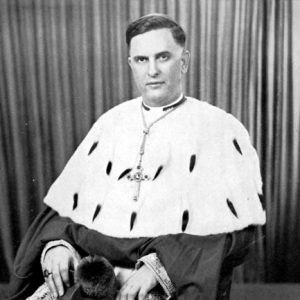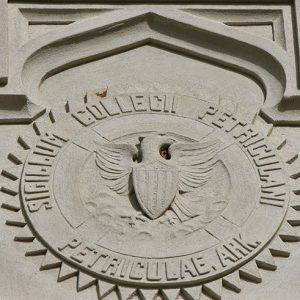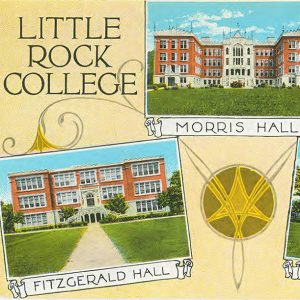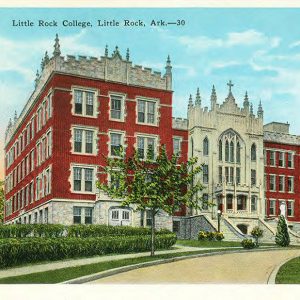calsfoundation@cals.org
Little Rock College
Little Rock College was the second attempt by the Diocese of Little Rock to establish an institution of higher education. Andrew Byrne, Arkansas’s first Roman Catholic prelate, began St. Andrew’s College near Fort Smith (Sebastian County) in 1849, but it closed in 1861 due to the Civil War. John B. Morris, Arkansas’s third Catholic bishop, established Little Rock College using the wealth accumulated by his predecessor, Edward M. Fitzgerald, who died in 1907. Fitzgerald left so much to his successor that, in addition to the college, Morris eventually founded St. Joseph’s Orphanage in North Little Rock (Pulaski County), a diocesan newspaper, and a seminary.
Little Rock College opened in September 1908, situated between 25th and 26th streets, and Gaines and State streets. Father Dennis W. O’Hern served as its first president, and Father Winand Aretz served as vice president. These two clerics, together with five lay persons, made up the faculty for the first academic year. The college originally served only male students, twelve of whom were enrolled the first semester. The catalog listed courses in the liberal arts, along with mechanics, chemistry, electricity, mineralogy, geology, and astronomy. The next year, 1909–1910, the students were housed at the old St. Mary’s Academy across Louisiana Street from St. Andrew’s Cathedral. St. Mary’s Academy and the Mercy sisters had by then moved to Pulaski Heights (Pulaski County). By the end of the second year, there were forty-seven students enrolled at Little Rock College. After two years, O’Hern was replaced by an energetic young priest from New York, Father Herbert Heagney, who remained president from 1910 to 1923.
In 1911, the college was joined by a new seminary, St. John’s Seminary, and both institutions operated at the State/Gaines Street location. In 1916, both facilities moved to a new location in Pulaski Heights. At the same time, St. Joseph’s Orphanage then moved to the old college and seminary facility. Four years later, St. Joseph’s relocated back to North Little Rock, while St. John’s Seminary returned to the State/Gaines Street location. For the next decade, Little Rock College operated at the Pulaski Heights campus.
In opening this college and seminary, Bishop Morris hoped to raise the educational level of his clergy and lay people to counteract Arkansas’s anti-Catholic prejudice. The strength of this prejudice was illustrated in the fall of 1916. During a football game between Little Rock College and the Russellville Aggies (from what would later become Arkansas Tech University), fans vacated the stadium and began jeering at the Catholic team from the sidelines. The irate crowd then followed the winning Little Rock team to the train station, hurling insults.
One distinguished alumnus of Little Rock College is Arkansas’s fourth bishop, Albert L. Fletcher. Fletcher graduated from Little Rock College in 1917 with a degree in chemistry. He then entered the seminary and was ordained to the priesthood in 1920. After earning an MS degree in chemistry from the University of Chicago, Fletcher returned in 1920 to teach at his alma mater. In 1923, Morris made him president of Little Rock College, a position he held until 1925.
Little Rock College opened a pharmacy school in 1924, but it closed after three years. (Arkansas would not have another school of pharmacy until 1946.) In August 1928, the college announced that it would admit women, but that was not enough to keep it open. The Great Depression brought an end to the college, and Bishop Morris announced on July 12, 1930, that the school would close that fall. The seminary moved to the Pulaski Heights campus, and the old seminary grounds become Little Rock Catholic High School for Boys.
For additional information:
Archives of the Diocese of Little Rock. St. John’s Catholic Center, Little Rock, Arkansas.
Woods, James M. Mission and Memory: A History of the Catholic Church in Arkansas. Little Rock: August House Publishing Co., 1993.
James M. Woods
Georgia Southern University












Excellent article, thanks for taking the time and effort to write it. I had no idea that my grandfather, Oliver Eichelmann, attended this college until my cousin graciously gifted me three of grandfather’s yearbooks (1925, 1926, 1927) from this institution, but I didn’t know anything else about the college until I read this article, which fills in the informational gaps.
The yearbooks are fascinating. The 1925 edition has nice color images, as well as black and white photographs of the school buildings.
Also, I had always heard that Catholic High School was originally located near Roosevelt Road, but I had had no idea where it was. Also, this building is still standing.